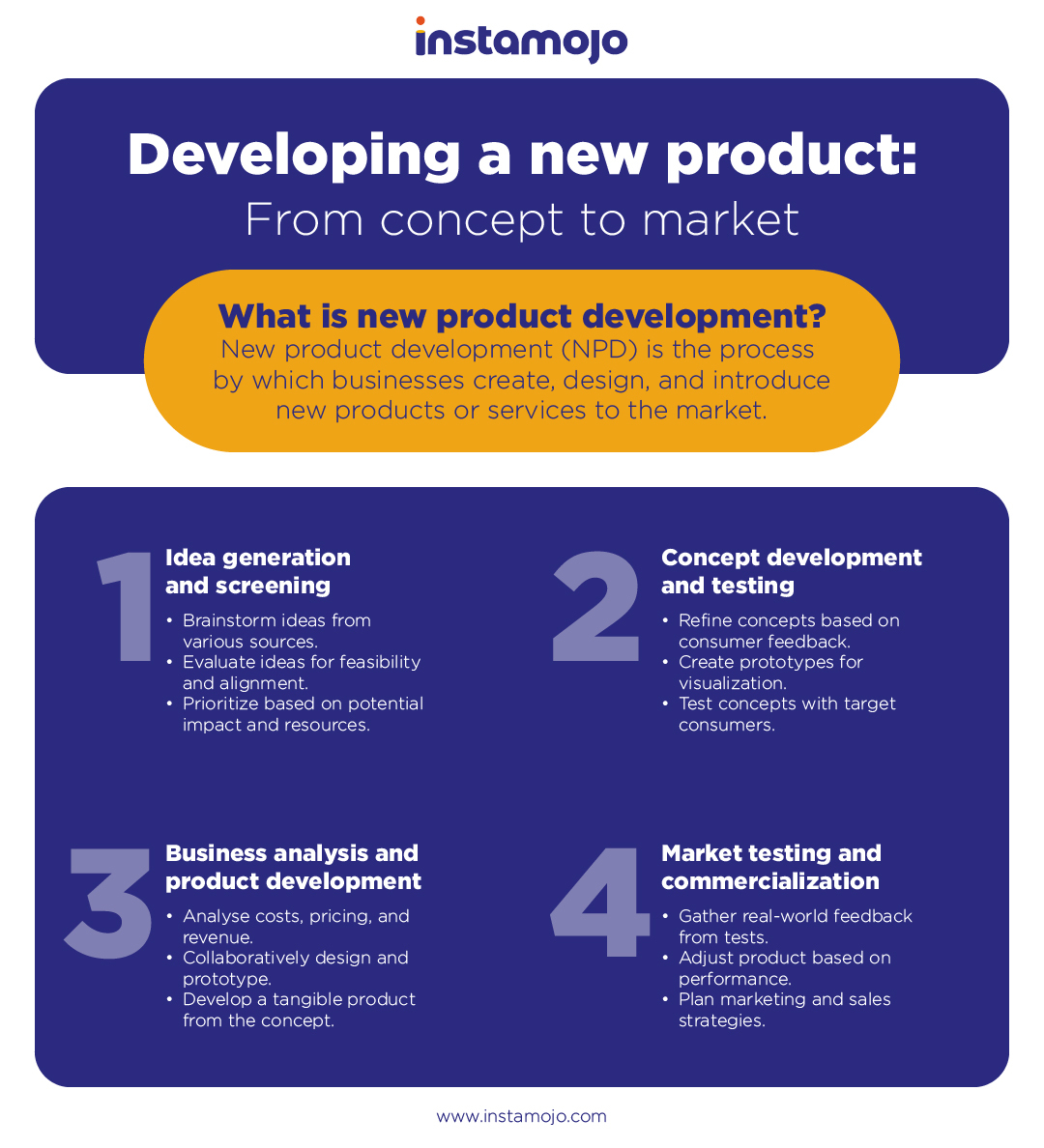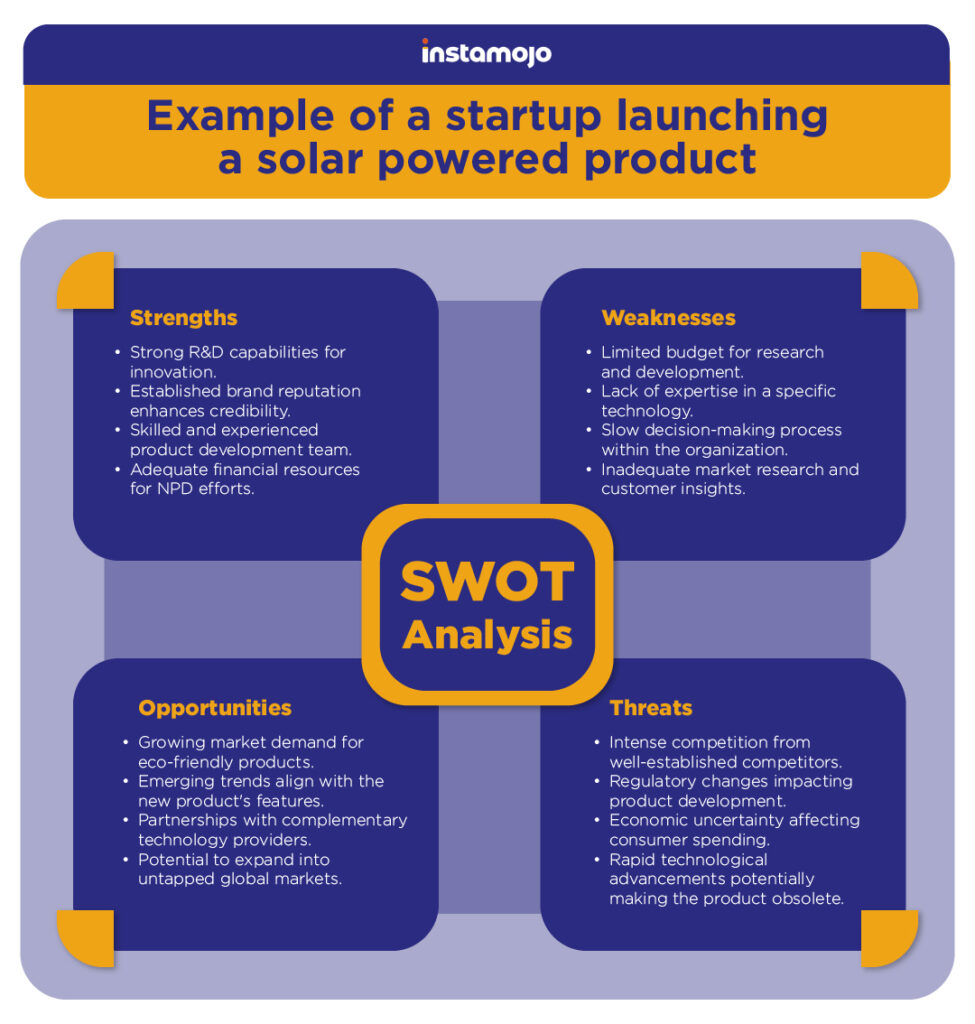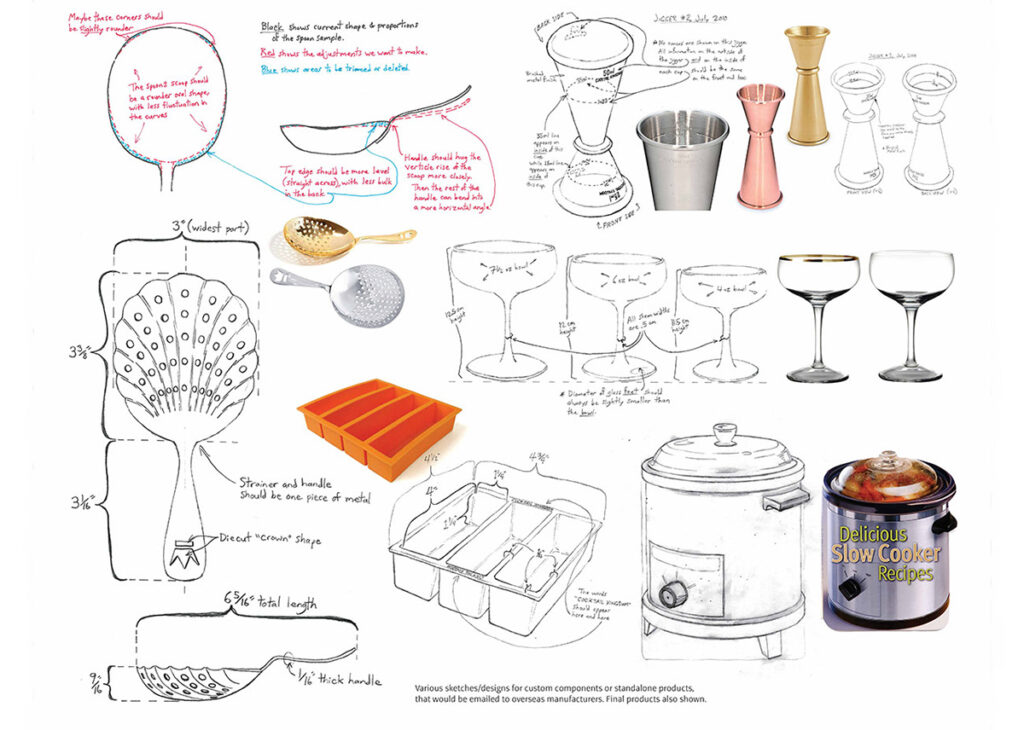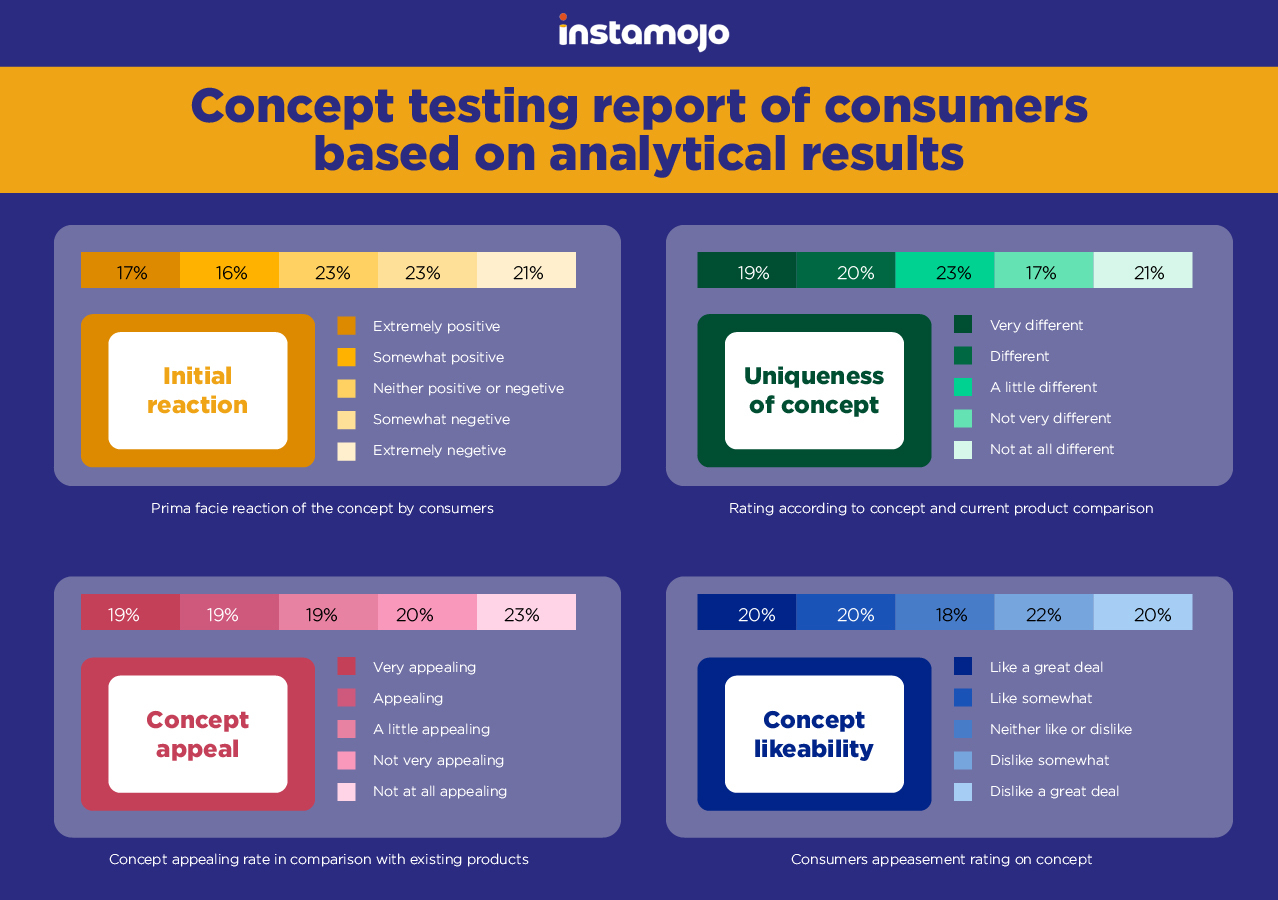Quick summary:
“New product development: From Concept to Market” is your ultimate guide to turning imaginative ideas into tangible realities. From brainstorming and refining concepts to designing, testing, and finding your market niche, this journey covers each and every step that will help you transform your idea into a successful product.
An eager entrepreneur is always working on 5-10 ideas at the same time. Are you the same? Do you have a lot of ideas but don’t know where to get started? Well, we are here to reveal the process. All the way from taking that simple piece of thought, to crafting its design and then seeing it flourish in the market!
This blog will cover everything from brainstorming to the big debut. Let’s go!
What is New Product Development (NPD)?
Ever wonder how your favourite companies keep churning out fresh, exciting stuff? Well, that’s what the magic of New Product Development (NPD).
NPD is the behind-the-scenes process that turns cool ideas into real things you can buy. NPD blends creativity, smart planning, and market savvy to create products that shake up the market and make our lives better.
Additionally, here is an exciting study on new product development that will blow your mind.
MIT Pro Education states that 30,000 new products emerge yearly., But out of them, a shocking 95% fail! Not even giants like Google are immune—Google Glass, despite investment, disappeared
How to be the 5% that succeeds? Follow the process of NPD methodically.



NPD is a series of steps that helps you analyse the market, evaluate your product’s potential profit margin, forecast demand and then launch to your target audience at the optimal cost.
The magic and importance of innovation in product development
Have you ever questioned why there’s such widespread excitement surrounding innovation and product development these days? Well, let’s break it down and see why they’re such a big deal in the world of business.
1. Keeping up with the times: Innovation and product development are like the GPS that guides a business through these twists and turns.
2. Standing out in the crowd Add that extra spice, that unique flavour. This sets you apart, giving you an edge that makes customers take notice and say, “Hey, this is something special!”
3. Dollars and sense: People love new and improved stuff. They’re willing to pay for it, too. This means businesses can open new doors to income streams they never knew existed.
4. Growing pains and gains: Growth frequently comes from doing something new, something better. Innovation gives companies a chance to expand, to take their slice of the market pie.
5. Fans for life: When they come up with products that solve problems and make life easier, customers don’t just buy once—they become loyal fans. It’s like turning customers into part of the family.
Nike is a notable example of a brand that fosters “Fans for life” through new product development. Their athletic shoes, apparel, and innovative technology consistently captivate sports and fitness enthusiasts, creating enduring brand loyalty and a dedicated fan base.
A guided walkthrough for the “new product development” process
The New Product Development process is not meant for ANY product launch. The key here is innovation and exclusiveness.
You’ve learnt what NPD is, now what? The next step is to shed some light on the procedure.
In short, how do you develop a new product?
For better understanding, let’s have a look at the infographic we’ve made for your reference discussing the process in short:

Now, here is a detailed breakdown of the steps that are involved in developing a new product:
Stage 1: Idea generation and screening or conceptualization
Imagine a bunch of creative minds in a room, tossing around ideas like confetti. This is where it all begins.
Idea generation in new product development is all about generating fresh, out-of-the-box concepts that could be the next big thing.
Whether it’s inspired by customer feedback, industry trends, or those “a-ha” moments in the shower, this phase is all about dreaming big.
Once you have a list of ideas that you think hold potential, you now need to “screen them”. Screening refers to the process of shortlisting those ideas based on their obvious drawbacks.
To do it:
- Generate ideas: Brainstorm and gather feedback.
- Pick good ones: Evaluate ideas for practicality and demand.
- Test concepts: Make prototypes and gather customer feedback from your community
- Decide: Use data to decide which ideas to pursue.
Tesla is a standout example in New Product Development. They’ve disrupted the automotive industry with electric vehicles that combine cutting-edge technology, sustainability, and high-performance, setting them apart from traditional car manufacturers. Here’s an interesting case study of how they develop their products!
Related read: 11 Low-cost business ideas you can start online in 2023
Stage 2: Market research and validation
Alright, we’ve got our pile of ideas. Now what? Time to put on our detective hats and conduct market research.
It is important because this research would help you:
- Know customers: They help you understand what customers want.
- Reduce risk: Avoid launching products that people don’t like.
- Stay competitive: Learn about market trends and competition.
So dive into surveys, chat up focus groups, and spy on competitors to see if your ideas make sense in the real world. We’re all about making sure your brainwaves sync with what people want.
Discover Instamojo premium plans
Here are the 5 things you should absolutely do in market research for your new product:
1. Identify the pain point that you plan to resolve: Create a buyer persona and highlight the specific pain points that you are sure your product can solve.
2. Analyze customer needs: Cross-check with your target audience to see if their needs are the same as the pain point that you chose.
3. Research market trends: Track changes in consumer preferences, industry regulations, laws, etc., to stay ahead of the competition. Use Google Trends for this!
4. Conduct surveys: Survey your target customers to get insights into their buying behaviour, preferences and opinions.
5. Analyze competitors: Monitor competitor’s pricing, products, promotions, etc., to better understand their strategies and capitalize on market opportunities Use SWOT analysis.
Imagine you are thinking about launching a solar-powered product. This would be an example of a SWOT analysis that will help you analyse your competitors:

Once you do all of these, you will have a better idea of what your product idea lacks and the competition that it will have to face. This phase of refining your product idea based on community feedback is known as “validating the product idea”
Related read: How to define and reach your target audience as an eCommerce business
Stage 3: Product design and development
Lights, camera, action! Once you’ve found your golden ticket idea, it’s time to bring it to life on paper and screen.
First. Will you be able to manufacture and bring the product to life yourself? (We stan soloplrenuers!)
Or do you need a team? If yes, knowing how to hire correctly is crucial.
In this stage, you need to create a prototype of your product. It could be a simple sketch of the product.
Put down your product idea on paper in as many details as possible. And
- Explore all features
- Include dimensions
- Functionality
- Look and feel of the product
- The material it should be made of
- Chemical formulation (if relevant)
- Its Unique Selling Proposition

Once you have a rough idea of how it should look and feel – you can now enter the next stage of the New Product Development process.
Stage 4: Manufacturing and Production
Alright, the design now looks really cool and smooth. But how do we actually make this thing? Manufacturing is where the rubber meets the road.
When it comes to creating new products, how one can do it?
Think of it like baking the perfect cake – the right ingredients, the perfect timing, and voilà! Let’s make it easier. For manufacturing and producing a new product all you have to gear up for is:
- Materials are carefully selected
- Machines are up and running
- Quality control is vigilant
You can make the product at home, or you can choose manufacturers who would be able to make the product based on your directions.
Pro tip: Choose 5 to 6 manufacturers to show you samples so that you can do a quality check on each.
On to a Minimum Viable Product
This first development of your product that can actually be sold to a customer is known as the Minimum Viable Product.
A Minimum Viable Product is the most basic version of a new product that does what it promised to do. The MVP acts as the litmus test for the market and gets genuine feedback on all its flaws.
Stage 5: Marketing and branding
Now that we’ve got our masterpiece ready, it’s time to show it off to the world.
Before you are ready to launch the minimum viable product, check:
- The name of the product is finalised
- It’s colours match your brand
- Your content strategy is finalised
- You have highlighted your USP
- The product description is snazzy and informative
- Your social media platforms are ready to launch
- You have started creating a buzz in the market that “something is dropping”
A killer marketing strategy gets your product in the spotlight.
It’s all about creating buzz and making people think, “I need that in my life!” So, how to achieve this buzz?
Stage 6: Launch and distribution
After marketing, it’s a phase of launching your product.
The stage is set, the audience is waiting, and the curtain rises. It’s showtime!
To execute a successful launch:
- Plan launch: Set a strategic launch date and location.
- Production scaling: Prepare to meet market demand while maintaining quality.
- Distribution network: Establish partnerships with retailers or set up online channels.
- Feedback loop: Continuously gather feedback and adapt strategies for better results.
Here is a 7-step checklist to ensure your product sees an explosive launch
This is how majorly the launch and distribution phase works. But, during this phase, keep yourself posted with the following, whether:
- Inventory is stocked
- Sales teams are pumped
- Marketing campaigns hit the ground running
And just like that, your creation is out in the wild, ready to make its mark.
Related read: Launching the Instamojo ‘Builder’: Your ultimate customisation tool
Stage 7: Post-launch evaluation and improvement
And there’s your product out there in front of the world. But wait, the story doesn’t end at “happily ever after.” The real-time feedback starts pouring in – the good, the bad, and the “needs improvement.”
This phase is all about listening, adapting, and evolving. You’ll tweak, upgrade, and fine-tune based on what customers love and what needs a little polish.
As you go through each phase, you’ll notice important elements that consistently matter. These include testing, decision-making, customer understanding, and feedback. They are crucial for success in every stage of new product development.
Here is a framework to evaluate how well your MVP was appreciated in the market:

6 awesome global new product development examples 
Imagine holding a revolutionary gadget, using an app that changes the way you work, or tasting a food item that’s unlike anything you’ve ever experienced.
These are the outcomes of the captivating process known as New Product Development (NPD). NPD takes abstract ideas and transforms them into tangible innovations that shape our lives.
From tech giants to startups, NPD is a shared journey of success. Let’s explore some real examples, revealing how ideas become reality.
1. Apple’s iPhone: The phone that became everything
Cast your mind back to 2007 when Apple dropped the iPhone bomb. It wasn’t just a phone – it was a universe in your pocket. The iPhone blended a phone, a music player, and the internet into one sleek gadget. Suddenly, we were swiping, tapping, and FaceTiming our way into a new era.
Apple’s iPhone is often considered one of the best examples of successful new product development for several reasons:
- Innovation: Redefined smartphones with a versatile, user-friendly device.
- Market research: Met diverse consumer needs through in-depth research.
- Iterative development: Continuously improved features and performance.
- Marketing excellence: Successfully communicated value to a global audience.
2. Tesla’s electric vehicles: Cruising toward tomorrow
Tesla hit the road in 2012 with electric cars that looked like they came from the future. The Model S wasn’t just eco-friendly; it was fast, luxurious, and smarter than a supercomputer. From self-driving tech to those over-the-air updates, Tesla made driving an electric vehicle feel like magic.
Tesla’s electric vehicles shine in new product development:
- Improvement: Kept EVs competitive through upgrades.
- Charging network: Built Superchargers for convenience.
- Customer-centric: Listened to feedback for enhancements.
- Ecosystem growth: Expanded into energy products.
- Strong brand: Drew loyal customers, ensuring sustainability.

3. Amazon Echo: Alexa, your personal assistant
Meet Alexa, Amazon Echo’s chatty buddy. Back in 2014, these little devices started doing more than playing tunes – they answered questions, set reminders, and even ordered you toilet paper. The Alexa brought the future to our living rooms and showed us that homes can be smart, too.
Amazon echo: Alexa excels in new product development because:
- Voice-first innovation: Pioneered voice-controlled smart speakers.
- Iterative enhancement: Regularly improved hardware and software.
- Ecosystem building: Developed Alexa Skills Kit for third-party apps.
- Integration: Seamlessly integrated with Amazon services, enriching its functionality.
4. Google: The answer to all our questions
Google is like our digital best friend who knows everything. Back in the day, finding answers meant digging through books. Then Google came along, making information a search away. It turned us all into experts and made the internet our go-to encyclopedia.
Google stands as a prime example of superior new product development because:
- User focus: Prioritizes user needs and feedback.
- Diverse portfolio: Offers a wide range of products.
- Strategic acquisitions: Grows through acquisitions and partnerships.
- Global impact: Scales products globally
5. Netflix: Binge-watching’s best friend
Netflix took TV and movies to the next level. From mailing DVDs to streaming everything online, they changed how we watch. Original shows like “Stranger Things”, “Kota Factory” and “Sacred Games” had us hooked, and suddenly, binge-watching became a socially acceptable hobby.
Netflix stands as a prominent illustration of new product development:
- Streaming revolution: Pioneered streaming, transforming entertainment.
- Original content: Created hit original shows and movies.
- Global expansion: Reached a worldwide audience.
- Continuous innovation: Adapts to evolving viewer preferences.

6. Zoom: Virtual hangouts made easy
Zoom wasn’t just a word; it was our lifeline. When the world needed to connect, Zoom delivered. It turned virtual meetings into a breeze and let us have film nights and virtual happy hours with friends. It’s the reason we could be apart yet still feel close.
Zoom serves as a standout example of new product development:
- Video conferencing: Redefined remote meetings and communication.
- Simplicity: Easy-to-use interface for broad adoption.
- Rapid growth: Achieved global prominence quickly.
- Scalability: Scaled to meet surging demand effectively.
How much does it cost to develop a new product?
The cost of developing a new product can vary a lot. It depends on how complex the product is, what materials are needed, and how much research and testing are involved.
- Research and development: Designing and testing the product can cost anywhere from a few thousand to millions, depending on how high-tech it is.
- Materials and manufacturing: The stuff you need to make the product and how it’s put together affects costs too.
- Testing and certification: Making sure the product is safe and meets standards can add more expenses.
- Marketing and launch: Getting the word out and packaging the product nicely comes with its own price tag.
- Distribution and sales: Getting the product to customers involves more costs like shipping and retail fees.
Challenges in new product development 
Here’s the catch now – NPD is not all smooth sailing. It’s like a thrilling adventure with obstacles that require ingenious solutions.
Think of it as a puzzle-solving quest. From anticipating customer desires to managing limited resources, NPD throws curveballs at every stage.
Therefore, here is a complete list of the challenges that you could face during the new product development process:
1. Reading the minds of customers
You know what’s tricky? Figuring out exactly what customers want. Sometimes, it’s like decoding ancient scrolls. But here’s the secret: market research is your compass.
What you can do?
- Dive into surveys
- Chats with potential users
- Observe user’s behaviour
It’s like detective work to uncover those hidden needs.
2. Nailing the trends
Just when you think you’ve got the trend nailed, a new one comes in. Rapidly evolving technology and changing consumer preferences can be difficult to keep track of! The trick here? Stay agile.
- Keep your radar up for the latest buzz
- Adapt your plans
- Make flexibility your best friend
Related read: How to start a lean and agile eCommerce business
3. Budgeting dilemmas
Budgets are like a finicky friend – they might not always be there for you. Limited funds can cramp your style, but here’s the hack: prioritize.
- Put your chips on projects that align with your big goals.
- Consider partnerships or collaborations to stretch your resources.
4. The cross-functional tango
Think of the different departments trying to walk in together. Sounds chaotic, right? Cross-functional collaboration can be a dance, but it’s a crucial one.
- Encourage open chats
- Break down silos
- Make sure everyone’s tapping to the same rhythm
5. Prepare for resistance
New products often bring new ways of doing things, and not everyone’s a fan of change. Cue the resistance music. The trick? Rally the troops early.
- Explain the “why” behind the change
- Offer support
- Let your team have a say in shaping the new direction
Innovate with Instamojo
And that’s a wrap for our thrilling ride through new product development! We hope you’ve had as much fun exploring the ins and outs of innovation as we did, bringing you these insights.
Remember, innovation isn’t just for the big shots – it’s a spark that can light up businesses of all sizes.
So, whether you’re a startup dreamer or a seasoned entrepreneur, keep those creative wheels turning, because you never know where your next groundbreaking idea might take you.
Start your journey by starting your own online store for your brand new product ideas! For absolutely FREE.


